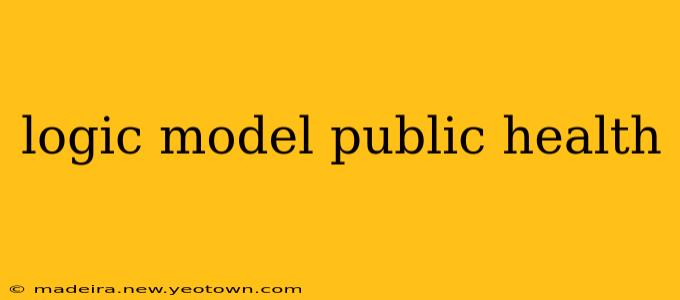Decoding the Logic Model: A Public Health Story
Imagine you're a detective investigating a public health crisis. You need a roadmap, a clear plan to understand the problem, implement solutions, and measure success. That roadmap is the logic model. It's a visual representation of how your program or initiative will work to achieve its goals, a story told through boxes and arrows.
This isn't just some abstract academic exercise; it's the backbone of effective public health interventions. It's how we move from identifying a problem like rising childhood obesity to implementing a successful school-based nutrition program. Let's delve into its components and see how it unfolds.
What is a Logic Model in Public Health?
A logic model in public health is a visual tool that explains the relationships between resources, activities, outputs, outcomes, and the overall impact of a program. It shows the "logic" behind why the program is expected to work. It's a roadmap, a "if-then" statement visualized: If we do these things, then we expect these results.
Think of it as a compelling narrative, structured to answer key questions:
- What are we doing? (Activities)
- What will we produce? (Outputs)
- What changes will result? (Outcomes)
- What is the ultimate effect? (Impact)
This framework allows for clear communication among stakeholders, facilitates evaluation, and ensures that everyone—from funders to community members—is on the same page.
Key Components of a Public Health Logic Model
Let's break down the essential components, using the example of a community-based diabetes prevention program:
1. Inputs: These are the resources needed to implement the program. For our diabetes prevention program, this could include:
- Funding: Grants, donations
- Personnel: Trained health educators, community volunteers
- Materials: Educational brochures, cooking demonstrations equipment
- Facilities: Community centers, clinics
2. Activities: These are the actions undertaken to achieve the program's objectives. In our diabetes prevention program, activities might include:
- Educational workshops: On healthy eating, physical activity, and diabetes management
- Community outreach events: Health fairs, screenings
- Support groups: For individuals with diabetes or at high risk
3. Outputs: These are the direct products of the program's activities. For the diabetes program, this could involve:
- Number of workshops conducted
- Number of people reached through outreach
- Number of support group participants
- Number of educational materials distributed
4. Outcomes: These are the short-term and intermediate-term changes resulting from the program's activities. Outcomes can be divided into:
- Short-term outcomes: Increased knowledge about diabetes prevention, improved dietary habits, increased physical activity.
- Intermediate-term outcomes: Reduced incidence of pre-diabetes, improved blood glucose control.
5. Impact: This is the long-term, significant change resulting from the program's outputs and outcomes. For the diabetes prevention program, this might be:
- Reduced rates of type 2 diabetes diagnosis in the community
- Improved overall health and well-being of community members
How to Develop a Logic Model for Your Public Health Program
Developing a robust logic model requires careful planning and stakeholder involvement. It's not a one-person job. Here's a suggested process:
- Define the program's goal: What is the ultimate change you aim to achieve?
- Identify the key activities: What actions will be taken to reach the goal?
- Determine the outputs: What tangible results will the activities produce?
- Specify the outcomes: What short-term and long-term changes are expected?
- Describe the impact: What significant changes will occur as a result of the program?
- Visualize the relationships: Use a diagram or chart to connect the different components.
- Review and refine: Seek feedback from stakeholders to ensure accuracy and clarity.
Frequently Asked Questions (PAA)
How is a logic model used in program evaluation? A logic model provides a framework for evaluating a program's effectiveness. By monitoring outputs and outcomes, you can assess whether the program is achieving its intended results and identify areas for improvement.
What are the benefits of using a logic model? Logic models improve communication, enhance planning and evaluation, secure funding, and improve program effectiveness.
What are some common mistakes to avoid when creating a logic model? Avoid overly complex models, focusing instead on clarity and simplicity. Ensure all components are clearly defined and linked. Avoid making assumptions without supporting evidence.
Can a logic model be used for different types of public health interventions? Absolutely. The logic model is a flexible tool that can be adapted to any public health intervention, from disease prevention campaigns to health promotion programs.
How can I make my logic model more effective? Involve stakeholders throughout the process, use clear and concise language, regularly review and update the model, and use visual aids to enhance understanding.
By understanding and utilizing the logic model, public health professionals can create more effective, evidence-based programs that significantly impact community health. It's more than a diagram; it's a blueprint for positive change.

